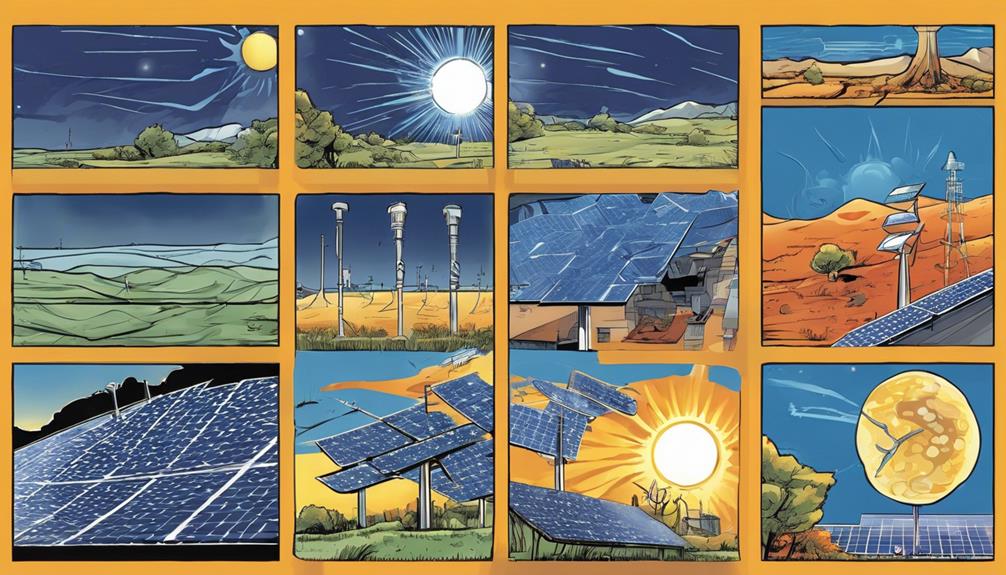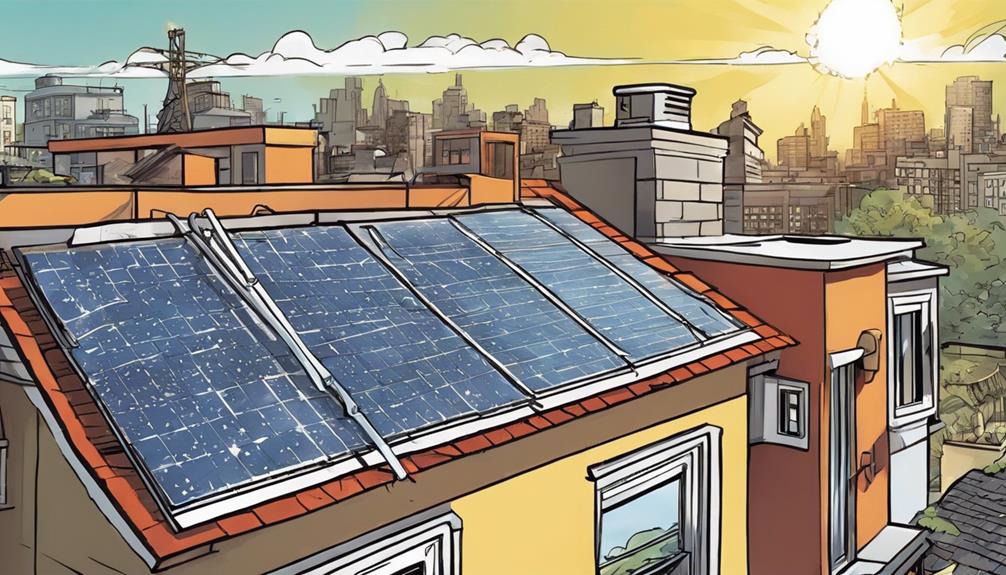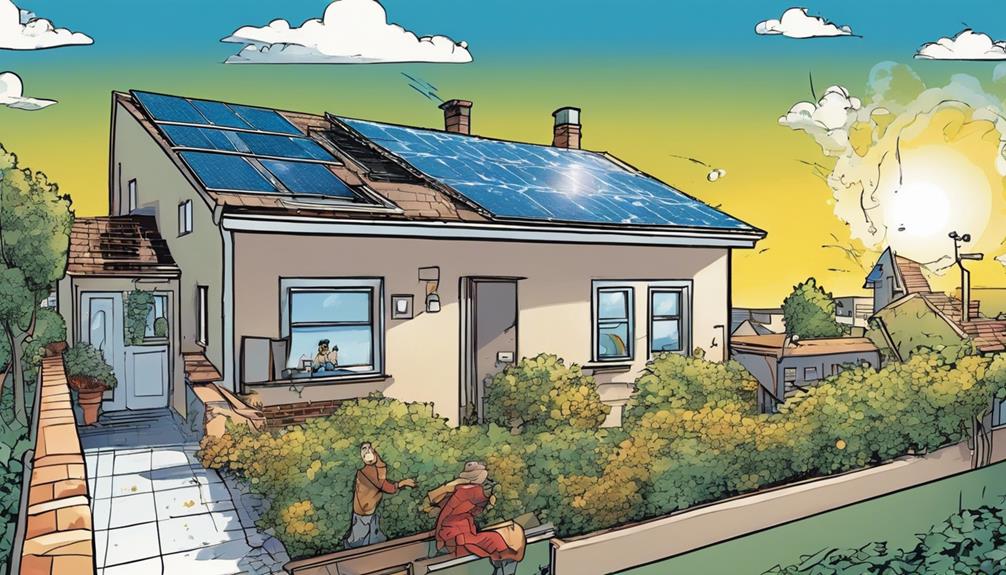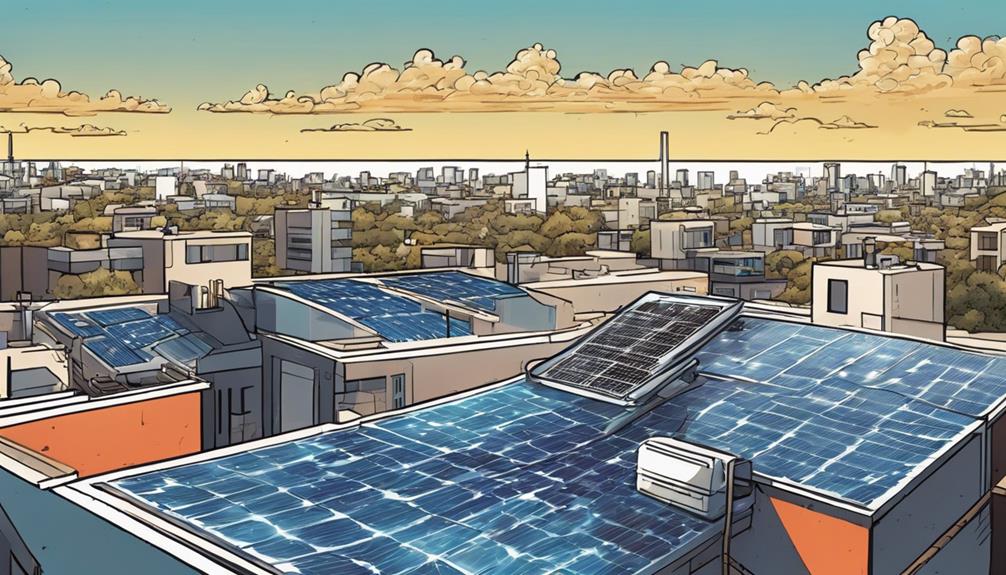Embrace the promising future with photovoltaic systems. Recent innovations in solar cells have propelled electricity generation to new heights. Focus on design, efficiency, and cost is paving the way for sustainable energy solutions. With advancements like perovskite cells and energy storage integration, the potential for efficient energy capture is expanding. Discover how materials sustainability and climate tech collaborations are reshaping the solar energy landscape. Exciting developments in PV device innovation and solar cell research forums are driving the quest for greener energy. Explore the cutting-edge advancements shaping the future of solar energy!
Key Takeaways
- Continuous innovation in PV devices for sustainability.
- Emphasis on materials sustainability and resource reduction.
- Integration of energy storage for optimized energy capture.
- Advancements in perovskite and tandem solar cells for efficiency.
- Collaborations shaping a sustainable energy future.
PV Device Innovation Impact
Enhance the impact of PV device innovation on solar energy by fostering collaboration and driving performance improvements. The recent advancements in solar cells have propelled PV deployment to unprecedented levels, with over 1,000 TWh of electricity generated in 2022 alone. This surge can be attributed to the relentless focus on enhancing the design, efficiency, and cost-effectiveness of PV devices, accelerating their adoption on a multi-TW scale for a sustainable energy ecosystem.
Researchers at NREL stress the pivotal role of continuous innovation in PV devices for the future of solar energy. Even small enhancements in solar cell efficiency can yield substantial benefits, particularly at terawatt scales, underscoring the significance of ongoing improvements in this domain.
Collaboration and interdisciplinary efforts emerge as essential components in driving impactful device innovation within the solar energy sector, steering progress towards a greener and more sustainable energy future. By fostering synergies and pushing the boundaries of performance, the impact of PV device innovation can be maximized, paving the way for a more efficient and widespread deployment of solar energy technologies.
Past and Future Solar Cells

You've witnessed solar cell advancements focus on efficiency gains, cost reductions, and reliability enhancements in the past.
Now, the spotlight is shifting towards ensuring materials sustainability, exploring dual-junction devices, and reducing the use of scarce resources in future solar cell research.
Exciting prospects lie ahead as solar technology evolves to meet the challenges of sustainability and efficiency in the energy landscape.
Efficiency Advancements in PV
With recent advancements in solar cell efficiency driving the generation of over 1,000 TWh of electricity in 2022, the focus on improving efficiency, reducing costs, and enhancing reliability in past and future solar cells remains paramount.
To explore further into the efficiency advancements in PV, consider the following:
- Innovative Technologies: Researchers are exploring novel technologies such as perovskite and tandem solar cells to boost efficiency levels significantly.
- Improved Manufacturing Processes: Streamlining manufacturing processes to enhance the quality and efficiency of solar cells is a key area of focus for industry experts.
- Integration of Energy Storage: Combining solar cells with energy storage solutions like batteries to optimize energy capture and utilization is a promising avenue for improving overall efficiency.
Efficiency gains in solar cell technology not only drive increased energy production but also pave the way for more sustainable and cost-effective solar energy solutions. By prioritizing efficiency advancements, the solar energy sector continues to push boundaries in harnessing the power of the sun for a brighter, greener future.
Materials Sustainability in PV
Materials sustainability plays a crucial role in the past and future development of solar cells for photovoltaic systems. As solar technology advances, guaranteeing the responsible use of materials becomes increasingly important. The table below highlights key points regarding materials sustainability in PV:
| Materials Sustainability in PV | Key Points |
|---|---|
| Past Innovations | Efficiency, cost reduction, reliability |
| Challenges | Materials availability, supply chain |
| Future Innovations | Reduce scarce materials, circular tech |
| Research Emphasis | Coupling with other energy sectors |
Efforts in solar technology are shifting towards reducing the reliance on rare materials, adopting circular technologies, and exploring the potential of dual-junction devices. At a multi-terawatt scale, challenges such as materials availability and sustainable supply chain management must be addressed to ensure the long-term viability of solar energy systems. By emphasizing materials sustainability, the solar industry can continue its growth trajectory while minimizing its environmental impact.
Future Research Directions
Reviewing past and future solar cell innovations reveals key advancements in efficiency, cost reduction, and reliability improvements.
When considering the future of solar panels and energy production, it's crucial to focus on the following areas:
- Reducing Scarce Materials: Future research is exploring ways to minimize the reliance on rare elements in solar panel manufacturing, ensuring sustainability and cost-effectiveness.
- Implementing Circular Technologies: By promoting recycling and reusing materials in solar panel production, the industry can move towards a more circular economy, reducing waste and environmental impact.
- Exploring Dual-Junction Devices: Dual-junction solar cells, which can capture a broader spectrum of sunlight, are a promising avenue for enhancing energy production efficiency and overall performance.
Addressing these aspects not only enhances the efficiency and effectiveness of solar panels but also contributes to the broader goal of sustainable energy production for a greener future.
New Device Research Forum

The New Device Research Forum introduces cutting-edge advancements in device-oriented PV research, fostering innovation for sustainable energy solutions. The journal Device focuses on PV device research, with a recent article by NREL researchers emphasizing the importance of creativity in solving energy challenges.
Interdisciplinary contributions are highlighted, aligning with NREL's mission to drive innovation in sustainable energy systems. The inaugural edition of Device features a significant PV device article that inspires advancements in solar cells for tangible real-world impact. Nancy Haegel underlines the critical role of device innovation in shaping the future of the global energy system, emphasizing that even minor improvements can have a substantial impact at the terawatt scale.
Collaboration across disciplines and a focus on innovative PV device research are essential for addressing global challenges and moving towards a sustainable energy future. By pushing the boundaries of device-oriented PV research, the New Device Research Forum paves the way for transformative advancements in solar energy technology.
Small Improvements in PV Deployment

Enhancing the efficiency of PV devices through small improvements is essential for scaling up solar energy deployment globally. Even minor advancements in solar cell technology can have a significant impact on the power generation capabilities of the solar industry.
Nancy Haegel stresses the necessity for continuous innovation in PV devices to drive significant growth in deployment rates. Small improvements in PV deployment are important for shifting towards a sustainable energy system. Recent research by NREL researchers underscores the significance of innovation in PV devices for the future of solar energy.
Small enhancements in solar cell efficiency can lead to significant increases in power generation.
Incremental improvements in PV technology play a crucial role in the expansion of the solar industry.
Continuous innovation in PV devices is vital for meeting the growing energy demands sustainably.
Silicon Solar Cell Limits
To explore the challenges faced by silicon solar cells, it's important to understand their efficiency limitations and the potential for improvement through innovative technologies like perovskite cells.
Silicon solar cells encounter a theoretical efficiency barrier of 29%, which restricts further enhancements in efficiency. However, the introduction of perovskite solar cells has shown promise, offering higher absorption coefficients and achieving efficiencies of up to 31.25% when used in conjunction with silicon cells.
Despite these advancements, stability remains a concern for perovskite cells when exposed to moisture. As a solution, researchers are actively working on addressing these stability issues to guarantee the viability of perovskite/silicon tandem cells.
Experts, including Martin Green, view silicon-based tandem cells as the next evolution in solar technology, showcasing progress in both stability and efficiency through ongoing research and field trials.
The integration of perovskite cells with silicon cells presents a pathway towards overcoming the efficiency limitations of traditional silicon solar cells.
Next-Gen Climate Technology Backing

You'll find that companies backed by influential investors are propelling next-gen climate technology forward, with a strong focus on innovative solar solutions like perovskite cells.
Bill Gates' Breakthrough Energy Ventures and other key players are driving advancements in the solar energy sector through strategic investments.
These collaborations are shaping the future of sustainable energy and paving the way for cutting-edge climate tech innovations.
Climate Tech Innovations
Investing in next-gen climate technology innovations is essential for driving impactful change in combating climate change and promoting sustainable energy solutions like solar power. These cutting-edge advancements play a significant role in accelerating the shift to a greener future. By focusing on climate tech innovations, particularly in solar power, we pave the way for a more sustainable energy system.
Here are three key aspects to keep in mind:
- Renewable Energy Focus: Climate tech innovations center on advancing renewable energy sources such as solar power, which are crucial for reducing carbon emissions and mitigating the effects of climate change.
- Global Climate Goals: Investments in climate tech are vital for achieving global climate goals and creating a more sustainable environment for future generations.
- Greener Future: Embracing climate tech advancements, especially in solar energy, is essential for paving the way towards a cleaner and greener future.
Next-Gen Solar Solutions
Focusing on advancing solar solutions like perovskite solar cells through Next-Gen Climate Technology Backing propels the development of more efficient and cost-effective solar energy technologies. The Department of Energy and other investors are actively supporting innovative solar technologies to enhance efficiency and drive down costs. Perovskite solar cells, known for their higher efficiency and lower costs, have garnered substantial investments for future solar energy development. By emphasizing next-generation solar solutions, the aim is to increase the competitiveness of solar energy and pave the way for a more sustainable and efficient future.
| Next-Gen Solar Solutions | Benefits |
|---|---|
| Perovskite Solar Cells | Higher efficiency |
| Advanced Solar Technologies | Lower costs |
| Next-Gen Climate Technology Backing | Increased competitiveness |
| Department of Energy Support | Enhanced efficiency |
| Future of Solar Energy | Sustainable development |
Performance Outside Lab Questions

Understanding how solar devices perform outside the lab setting is important for evaluating their real-world effectiveness and reliability.
When it comes to evaluating the performance of photovoltaic systems in real-world conditions, there are a few key factors to take into account:
- Weather Variability: Real-world performance can be significantly influenced by weather conditions such as sunlight intensity, temperature variations, and cloud cover.
- Installation Quality: The way solar panels are installed plays an important role in their performance. Factors like tilt angle, shading, and orientation can impact efficiency.
- Regular Maintenance: Proper maintenance of PV systems is crucial for optimizing performance over time. Cleaning panels, checking for shading issues, and monitoring system output are essential for long-term efficiency.
Japans On-Building Perovskite Experiments

Japan's advancements in perovskite technology are evident through on-building experiments that showcase the country's commitment to integrating high-efficiency solar cells into new housing projects by 2025.
Companies like Panasonic have made remarkable strides in this field, developing a 30cm-square perovskite-only cell with the world's highest efficiency. This innovation highlights Japan's leading position in perovskite technology.
The focus in Japan is on creating thin and versatile perovskite panels that can be seamlessly integrated into buildings, addressing the challenge of limited land availability for solar projects. The versatility of perovskite cells extends beyond just replacing traditional silicon panels, with potential applications expected to contribute significantly to sustainability goals.
Noteworthy, Panasonic's inkjet printer for thin-film perovskite cells underscores Japan's dedication to commercializing high-efficiency perovskite technology, setting a strong foundation for the future of solar energy in the country.
Frequently Asked Questions
What Is the Future of Photovoltaic Energy?
In the future, photovoltaic energy will continue to grow in importance, with advancements driving increased efficiency and reduced costs. Innovations in PV technology are essential for achieving a sustainable energy system and meeting future demands.
What Is the Future Scope of Solar Photovoltaic System?
In the future, the scope of solar photovoltaic systems will expand globally, meeting a quarter of electricity needs by 2050. Continued advancements in technology are driving cost reductions and performance enhancements for better integration.
What Is the Future Technology of Solar Energy?
In the future, solar energy will incorporate advanced perovskite cells and cutting-edge storage tech. Breakthroughs in AI will optimize panel placement. Collaborative efforts drive innovation. Remember, the future of solar tech is bright and ever-evolving.
What Is the New Solar Panel Technology in 2024?
In 2024, the new solar panel technology includes advancements like perovskite solar cells and bifacial modules, enhancing efficiency and expanding solar power applications. Breakthroughs in energy storage solutions are also reducing costs and improving integration.
How Will Photovoltaic Systems Impact the Future of Solar Energy in 2024?
In 2024, renewable energy innovations 2024, such as photovoltaic systems, are expected to have a significant impact on the future of solar energy. These systems will offer more efficient and cost-effective ways to harness solar power, making renewable energy sources a more viable option for sustainable energy production.
Conclusion
As you look to the future of solar energy, remember that photovoltaic systems are leading the charge.
With ongoing innovation and research, these systems are pushing the boundaries of what's possible.
So, don't be left in the dark – embrace the power of solar energy and watch as it shines brightly in the years to come, like a beacon of hope in a world hungry for sustainable solutions.










